Educational Pathways
Page Navigation
- School District U-46
- Reasons for Change
Reasons for Change
-
Across the country, educators and families are grappling with a confluence of challenging realities: Rising college tuition rates with a national college debt tally in the $1.4 trillion range, representing the second highest level of consumer debt behind only mortgages. At the same time, the nation has seen strikingly high post-secondary remediation rates, meaning more than half of all community college students and nearly as many four-year college students must take remedial coursework in college to re-learn and master concepts they missed in high school.
 Meanwhile, employers continue to identify jobs that need to be filled in order to maintain and strengthen the U.S. economy. A 2013 Georgetown University study reported that by 2020, 65 percent of all jobs will require post-secondary education and training beyond high school. Through that same year, the nation is also expected to see 55 million job openings, most from baby boomer retirements but 24 million from newly created jobs. The United States is expected to fall short, according to the study, by at least five million workers with post-secondary education.
Meanwhile, employers continue to identify jobs that need to be filled in order to maintain and strengthen the U.S. economy. A 2013 Georgetown University study reported that by 2020, 65 percent of all jobs will require post-secondary education and training beyond high school. Through that same year, the nation is also expected to see 55 million job openings, most from baby boomer retirements but 24 million from newly created jobs. The United States is expected to fall short, according to the study, by at least five million workers with post-secondary education.Finally, and perhaps most importantly, there is a growing recognition that we must support students’ social and emotional needs and give them the tools, resources and a supportive environment for a safe and healthy school life that is rich in strong and positive relationships, free from bullying, threats and violence.
One emerging solution is to provide a clear pathway, lined with more rigorous courses, opportunities for career exploration and increased guidance, all housed within a small, supportive learning community within a large high school.
The School District U-46 community already recognizes the success of such small learning communities through its current High School Academies. Graduates of these academies do well in college and careers. Many give credit to the lessons learned within their academy, even those who now work in a career other than their academy’s focus.
Matt Wahl, a 2012 graduate of Larkin High School’s Visual and Performance Arts Academy is among those who believe the small learning environment gave him an advantage in college where he majored in music.
“If you go through the academy, one thing you discover is a point where teachers are not necessarily teachers,” says Wahl. “They are mentors, but they are also friends, I mean if you are going to be spending eight hours a day with a teacher, you had better have a good relationship with them. I think that personal relationship allowed for a deeper level of teaching to occur.
“Even on days when we could go home early, you would often find students sitting in the music wing of the school talking with teachers. I still to this day cannot get over seeing the joy and true happiness and enthusiasm that the teachers had. That made coming to class really exciting. For a teacher to spend that much time with their students, it really shows their dedication to their job and what they enjoy.”School District U-46 wants to make these small learning communities available to all students. We believe all our students deserve to have access to the most engaging and relevant coursework. These small learning communities provide students with career knowledge and skills that will serve them in both the workforce and college.
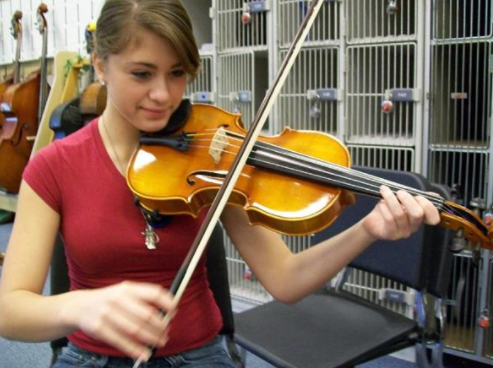
Academic data, as well as local Board policy and state and federal legislation drive this work, but so does the need to better support our students, to create more personal and sustaining relationships to help them thrive socially and emotionally as well as academically.
We live in an age when, nationally, more than 46 percent of U.S. youth—34 million children under age 18—have had at least one ACE, or Adverse Childhood Experience, such as the death or incarceration of a parent. More than 20 percent have had at least two. Our students are more connected technologically than ever before but many report they yearn for deeper, more meaningful connections. Educational research has long confirmed that building smaller learning communities betters supports students.
Some of the driving academic metrics include:
-
Freshmen on Track (to graduate): Illinois collects and reports data on a metric called “Freshmen on Track,” which refers to the percentage of ninth-graders who have earned at least five full-year course credits (10 semester credits) and have earned no more than one semester F in a core course (English, math, science or social science.)
- In U-46, four of our high schools are below the state average of 87 percent Freshmen on Track and one high school’s percentage rate is above the state average.
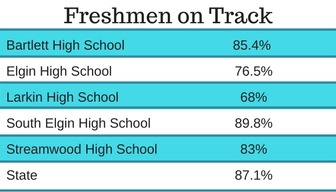
-
Graduation rates: Two U-46 high schools posted graduation rates in 2017 lower than the state average of 87 percent with the remaining schools above the state average.
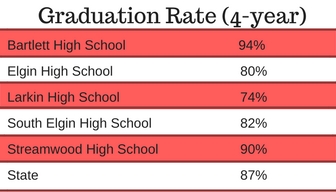
-
College Readiness: Two U-46 high schools fall below the state average of 51 percent of students earning an ACT of 21 or higher.
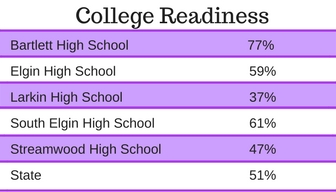
-
Post-Secondary Remediation: Every high school in U-46 has more students who require remediation at Illinois community colleges than the state average of 47 percent.
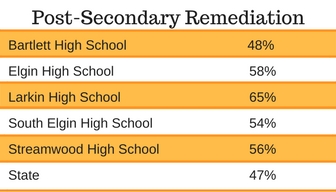
-
Local U-46 Priorities and Goals
Educators and lawmakers have been monitoring college and career readiness for more than two decades. In recent years, they have developed new policies and laws to improve outcomes. The School District U-46 Board of Education has established a series of metrics to meet the District's Strategic Plan. The goal is to:
- Increase the percent of students who are college and career ready. This can happen by meeting the following goals:
- Increase the number of unique high school students enrolled in Advanced Placement courses by 2 percent annually or attain 30 percent enrollment overall
- Increase the number of students graduating within five years by 3 percent annually or attain 99 percent overall
- Increase the number of high school students receiving industry credentials by 5 percent annually or attain 25 percent overall
As part of these goals, the District is working to increase the number of students taking Advanced Placement courses and began its dual-credit program during the 2017-18 school year.
State Legislation: College and Career Readiness
The State of Illinois has set a goal of ensuring that 60 percent of all adults have a college or career credential by the year 2025.
In fact, Illinois is leading the nation with the passage of the Postsecondary and Workforce Readiness Act (PWR), which was signed into effect on July 29, 2016. Under the act, education agencies must adopt a framework that outlines what students should know about college and career each year from eighth to twelfth grade. The framework must address, in an integrated way:
1) Career exploration and development
2) College exploration, preparation and selection
3) Financial literacy and accessing financial aid opportunities
The PWR Act also asks schools to provide career pathway endorsements on diplomas. These endorsements would be earned through following a specific career course sequence, or educational pathway, that includes a 60-hour internship or similar job shadowing and work experience.
Federal Legislation: College and Career Readiness
The Every Student Succeeds Act (ESSA) was signed by President Obama on Dec. 10, 2015, and established a set of required accountability measures for every state.
- One of the required measures included in ESSA is a college and career readiness indicator. This measure examines the extent that students are able to immediately go into the workforce upon graduation or take credit classes in college without the need for remedial coursework.
- Additionally, the Illinois ESSA Plan requires students to meet at least three of the following Career Readiness Indicators:
- Workplace learning career development experience
- Industry credential
- Military service (including ROTC)
- Dual-credit career pathway course (must earn an A or B grade for college credit)
- Completion of a program of study
- Attaining and maintaining consistent employment for a minimum of 12 months
- Consecutive summer employment
- 25 hours of community service
- Two or more organized co-curricular activities
Implementation of a career academy model will help the District raise student achievement and meet the academic aspirations identified by the Board of Education while also increasing dual-credit opportunities for students.
Finally, students as well as community members and business leaders want to collaborate to better support our students’ success and strengthen our communities with a long-term plan for strong civic involvement and a robust economy.

